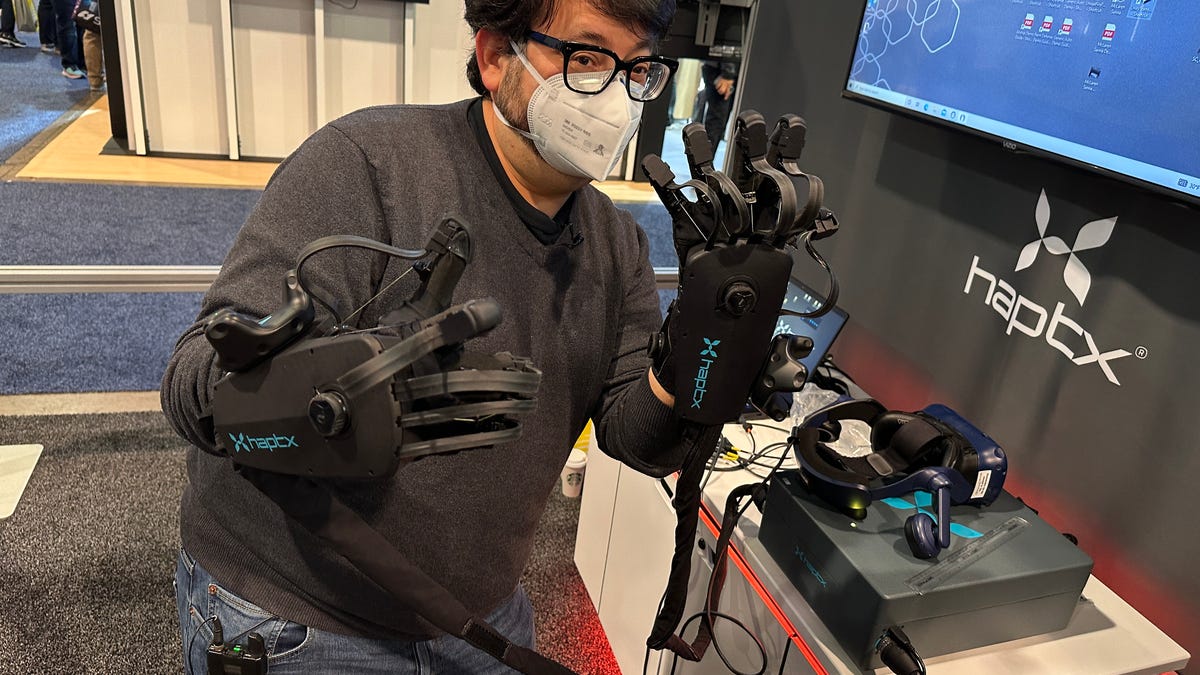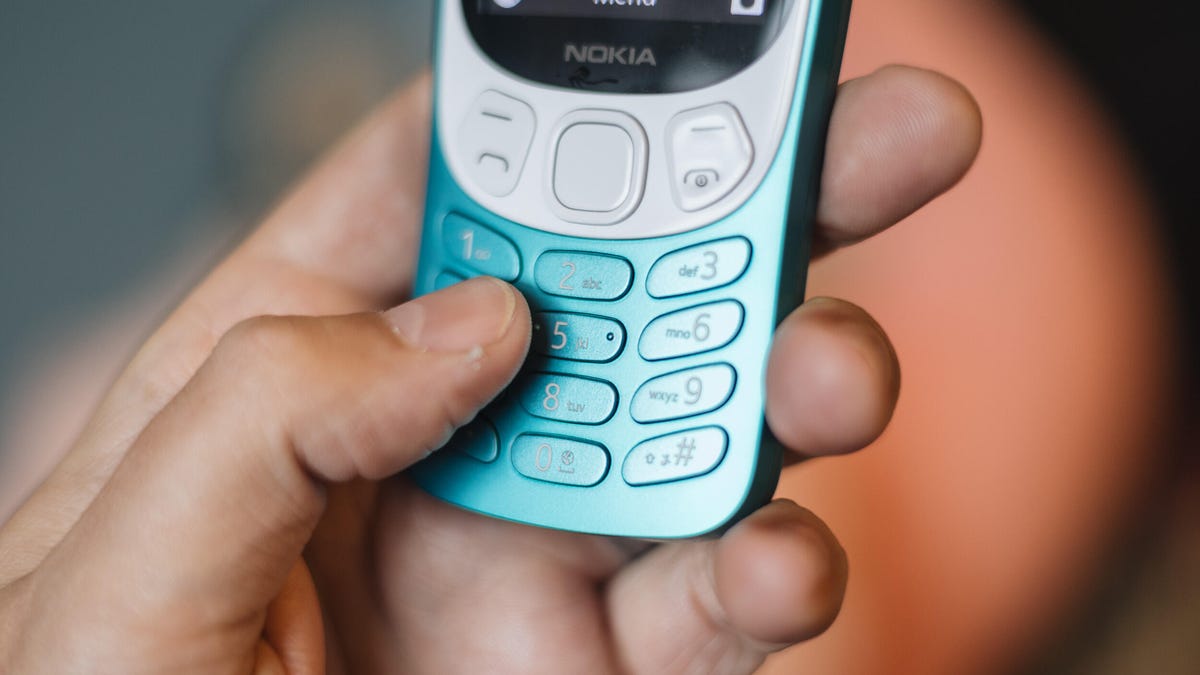Technologies
The Revelation I Got From Experiencing HaptX Is Wild
I tested gloves and buzzing things in Las Vegas to see where the future points.

I put my hands out flat and loaded them into a pair of gloves loaded with joints, cables, pumps and tightening straps. All of this was connected to a backpack-size box that helped pump pressure around my fingers and create sensations of touching things. I was about to play Jenga in VR using an $80,000 pair of haptic gloves made by HaptX.
The future of the metaverse, or how we’ll dip into virtual worlds, seems to involve VR and AR, sometimes. If it does, it’ll also mean solving what we do with our hands. While companies like Meta are already researching ways that neural input bands and haptic gloves could replace controllers, none of that is coming for years. In the meantime, is there anything better than the VR game controllers already out there or basic camera-based hand tracking? I’ve tried a couple of haptic gloves before, but I was ready to try more.
I poked around CES 2023 in Las Vegas to get some experiences with devices I hadn’t tried before, and it suddenly hit me that there’s already a spectrum of options. Each of them was a little revelation.
High end: Massive power gloves
HaptX has been recognized for years as one of the best haptic gloves products on the market, but I’d never had a chance to experience them. The hardware is highly specialized and also extremely large and expensive. I wish I’d gotten a chance to see them at the last CES I attended before this, in 2020. Finally, in 2023, I got a chance.
The gloves use microfluidics, pumping air into small bladders that create touch sensations in 133 zones per hand across the fingers and palm. At the same time, cables on the backs of the fingers pull back to simulate up to 8 pounds of force feedback. Used with apps that support them, you can reach out, grab things and actually feel them.
I’ve tried lower-cost haptic gloves at home that didn’t have the air bladders but did have cables to apply resistance. The HaptX gloves are a big step forward and the most eerily realistic ones I’ve ever tried. I wouldn’t say everything «felt real,» but the poking finger-feelings I had in my fingers and palms let me feel shapes of things, while the resistance gave me a sense of grabbing and holding stuff.
The most amazing moments were when I placed objects on my palm and seemed to feel their weight. Also, when another person’s finger virtually touched mine. Another journalist was in another VR headset with haptic gloves playing Jenga next to me. We never made contact, but occasionally we shook hands virtually or gave high-fives. Our fingers touching felt… well, oddly real, like sensing someone’s finger touching your glove.
HaptX is making another pair of smaller, more mobile gloves later this year that cost less (about $5,000) while still promising the same level of feedback, plus tactile vibrations like the haptic buzzes you might feel with game controllers. I didn’t get to demo that, but I can’t wait.
While HaptX’s tech is wild, it’s meant for industrial purposes and simulations. It represents actual reality, but it’s so massive that it wouldn’t let me do anything else other than live in its simulated world. For instance, how would I type or pull out my phone? Still, I’ll dream of interfaces that let me feel as immersed as these gloves can accomplish.
Budget gloves: bHaptics’ TactGloves
At $300, bHaptics‘ yellow haptic gloves are far, far less expensive than HaptX. They’re also completely different. Instead of creating pressure or resistance, all they really do is have various zones inside that electrically buzz, like your phone, watch or game controller, to sync up with moments when your fingers in VR would virtually touch something. Strangely, it’s very effective. In a few demos I tried, pushing buttons and touching objects provided enough feedback to feel like I was really «clicking» a thing. Another demo, which had me hug a virtual avatar mirroring my movements or shake hands, gave enough contact to fool me into feeling I was touching them.
bHaptics also makes a haptic vest I tried called the TactSuit that vibrates with feedback with supported games and apps. There aren’t many apps that work ideally with haptic gloves right now, because no one’s using haptic gloves. But bHaptics’ support of the standalone Meta Quest 2, and its wireless Bluetooth pairing, means they’re actually portable… even if they look like giant janitorial cleaning gloves. The tradeoff with being so small and wireless is their range is short. I had to keep the gloves within about two feet of the headset, otherwise they’d lose connection.
The buzzing feedback didn’t prove to me that I could absolutely reach into other worlds, but they offered enough sensation to make hand tracking feel more precise, Instead of wondering whether my hand gestures had actually contacted a virtual object, I could get a buzzing confirmation. The whole experience reminded me of some sort of game controller feedback I could wear on my fingers, in a good way.
No gloves at all: Ultraleap’s Ultrasonics
Ultraleap, a company that’s specialized in hand tracking for years, has a different approach to haptics: sensations you can feel in the air. I waved my hand above a large rectangular panel and felt ripples and buzzes beneath my fingers. The feelings are created with ultrasonic waves, high-powered sound bursts that move air almost like super-precise fans against your fingers. I tried Ultraleap’s tech back in 2020, but trying the latest and more compact arrays this year made me think about a whole new use case. It was easy to make this logic leap, since Ultraleap’s booth also demonstrated hand tracking (without haptic feedback) on Pico Neo 3 and Lynx R1 VR and mixed reality headsets.
What if… this air vibration could be used for headsets? Ultraleap is already dreaming and planning for this solution, but right now ultrasonic tech is too power hungry, and the panels too large, for headgear. The tech is mainly being used in car interface concepts, where the hand gestures and feedback could make adjusting car controls while driving easier to use and less dangerous or awkward. The range of the sensations, at least several feet, seem ideal for the arm length and radius of most existing camera-based hand-tracking tech being used right now on devices like the Meta Quest 2.
I tried a demo where I adjusted a virtual volume slider by pinching and raising the volume up and down, while feeling discrete clicks to let me know I was doing something. I could feel a virtual «bar» in the air that I could feel and perhaps even move. The rippling, subtle buzzes are far more faint than those on haptic gloves or game controllers (or your smartwatch), but they could be just enough to give that extra sense that a virtual button press, for instance, actually succeeded…or that a gesture to turn something on or off was registered.
If these interfaces move to VR and AR, Ultreleap’s representatives said they’d likely end up in larger installations first: maybe theme park rides. Ultraleap’s tech is already in experiences like the hands-free Ninjago ride at Legoland, which I’ve tried with my kids. The 3D hand-tracking ride lets me throw stars at enemies, but sometimes I’m not sure my gestures were registered. What if buzzing let me know I was making successful hits?
Haptics are likely to come from stuff we already wear
Of course, I skipped the most obvious step for AR and VR haptic feedback: smartwatches and rings. We wear buzzing things on our wrists already. Apple’s future VR/AR device might work with the Apple Watch this way, and Meta, Google, Samsung, Qualcomm and others could follow a similar path with dovetailing products. I didn’t come across any wearable watch or ring VR/AR haptics at CES 2023 (unless I missed them). But I wouldn’t be surprised if they’re coming soon. If AR and VR are ever going to get small enough to wear more often, we’re going to need controls that are far smaller than game controllers… and ways to make gesture inputs feel far less weird. Believe the buzz: Haptics is better than you think.
Technologies
Judge Blocks Texas App Store Age-Check Law
A preliminary injunction found the Texas law, set to begin Jan. 1, is «more likely than not unconstitutional.»

A new Texas state law set to take effect on Jan. 1 would have required app stores to implement age verification processes. But the law has been put on hold, at least temporarily, by a federal court judge.
As reported by the Texas Tribune, Senate Bill 2420, also known as the Texas App Store Accountability Act, is the subject of a temporary injunction issued by US District Judge Robert Pitman.
Pitman said in his decision that the law as written is broad, vague and «more likely than not unconstitutional.» However, he also wrote the court «recognizes the importance of ongoing efforts to better safeguard children when they are on their devices.»
Don’t miss any of our unbiased tech content and lab-based reviews. Add CNET as a preferred Google source.
The Texas law, signed into law by Governor Greg Abbott in May, requires app store operators — including Apple, Google, Nintendo, Steam and more — to build age verification processes for the storefronts and to only allow downloads to minors who obtain parental consent. The injunction is a ruling in an October lawsuit filed by the Computer & Communication Industry Association.
CCIA senior vice president Stephanie Joyce said in a statement, «This Order stops the Texas App Store Accountability Act from taking effect in order to preserve the First Amendment rights of app stores, app developers, parents, and younger internet users. It also protects parents’ inviolate right to use their own judgment in safeguarding their children online using the myriad tools our members provide.»
Other individuals and the advocacy group Students Engaged in Advancing Texas also filed suits over the law, the Texas Tribune reported.
App Store Accountability Act
The bill author, State Senator Angela Paxton, said the bill was meant to give parents «common sense tools to protect their kids and to survive court challenges by those who may have lesser priorities.»
The language of Texas Senate Bill 2420 does not only include mobile app stores from Apple or Google, but any «website, software application, or other electronic service that distributes software applications from the owner or developer of a software application to the user of a mobile device.»
By that definition, websites with links to browser games or mobile game consoles with download options would fall under the Texas law as written. The law also defines mobile devices as including phones and tablets, as well as any other handheld device capable of transmitting or storing information wirelessly.
The parental consent aspect of the law requires those under 18 to have an app store account affiliated with a parent or guardian to purchase or download applications.
Age verification elsewhere
In an effort to keep adult materials out of reach of minors and to protect children from potentially harmful content and interactions, tech companies have been compelled by law or through legal action to verify the age of users.
Roblox, which has a huge audience of minors, began rolling out stricter age verification after investigations and lawsuits hurt its reputation as a safe gaming space. Australia is perhaps the most large-scale example of a government restricting access to online content. In December, Australia began restricting social media access to those 16 and older. Reddit recently challenged that law.
In the US, age verification laws have primarily targeted adult sites. Texas already has a law on the books that requires adult sites to age-block their content. The Supreme Court upheld that law in a June ruling. The UK has also enacted age restriction rules for adult sites as have other US states.
Technologies
Today’s NYT Mini Crossword Answers for Thursday, Dec. 25
Here are the answers for The New York Times Mini Crossword for Dec. 25.

Looking for the most recent Mini Crossword answer? Click here for today’s Mini Crossword hints, as well as our daily answers and hints for The New York Times Wordle, Strands, Connections and Connections: Sports Edition puzzles.
Need some help with today’s Mini Crossword? Of course, there’s a very Christmassy clue involved. And once you solve the entire puzzle, look at the letters used in all the answers and see what they have in common. (5-Across will tell you!) Read on for all the answers. And if you could use some hints and guidance for daily solving, check out our Mini Crossword tips.
If you’re looking for today’s Wordle, Connections, Connections: Sports Edition and Strands answers, you can visit CNET’s NYT puzzle hints page.
Read more: Tips and Tricks for Solving The New York Times Mini Crossword
Let’s get to those Mini Crossword clues and answers.
Mini across clues and answers
1A clue: ___ King Cole, singer with the album «The Magic of Christmas»
Answer: NAT
4A clue: Body drawings, informally
Answer: TATS
5A clue: Letters to ___ (what this Mini was made with)
Answer: SANTA
6A clue: Huge fan, in slang
Answer: STAN
7A clue: «Illmatic» rapper
Answer: NAS
Mini down clues and answers
1D clue: Grandmothers, by another name
Answer: NANAS
2D clue: Abbr. before a name on a memo
Answer: ATTN
3D clue: Org. with long lines around the holidays
Answer: TSA
4D clue: «See ya later!»
Answer: TATA
5D clue: Govt.-issued ID
Answer: SSN
Don’t miss any of our unbiased tech content and lab-based reviews. Add CNET as a preferred Google source.
Technologies
Don’t Let a Border Agent Ruin Your Holiday Trip. Travel With a Burner Phone
Yes, you should leave your main phone at home and take a cheap burner this winter.

Prepare for a whole new level of border-crossing anxiety this holiday season: the high-probability of a phone search. New figures from US Customs and Border Protection say agents aren’t just glancing at your lock screen anymore — they are aggressively ramping up device inspections, even for citizens coming home. We aren’t just talking about a quick scroll through your photos, either. Agents are increasingly using forensic tools to clone and analyze everything on your device.
The stats are genuinely alarming. In just a three-month window this year, nearly 15,000 devices were flagged for searches, with over a thousand subjected to deep-dive data copying. If you’re traveling with your primary phone, you are essentially carrying your entire digital existence into a legal gray zone where privacy is optional.
The smartest defensive play is remarkably low-tech: the burner phone. By traveling with a secondary, stripped-down device, you ensure your private data stays safe at home while you stay connected abroad. But privacy isn’t the only perk. Moving to a «dumb» phone is the ultimate digital detox, helping you escape the notification trap that usually ruins a vacation.
Even figures like Conan O’Brien have ditched the smartphone to cut through the noise. Whether you’re dodging invasive border searches or just trying to enjoy your trip without being glued to a screen, a burner might be the best travel investment you make this year.
Read more: Best Prepaid Phone of 2025
Although carriers have offered prepaid phones since the ’90s, «burner phones» or «burners» became popular in the 2000s following the celebrated HBO series The Wire, where they helped characters avoid getting caught by the police. Although often portrayed in that light, burners aren’t only used by criminals; they’re also used anyone concerned with surveillance or privacy infringement.
What is a burner phone, and how does it work? Here’s everything you need to know about burners and how to get one.
Don’t miss any of our unbiased tech content and lab-based reviews. Add CNET as a preferred Google source.
What is a burner phone?
A burner phone is a cheap prepaid phone with no commitments. It comes with a set number of prepaid call minutes, text messages or data, and it’s designed to be disposed of after use.
Burner phones are typically used when you need a phone quickly, without intentions of long-term use. They’re contract-free, and you can grab them off the counter. They’re called burner phones because you can «burn» them (trash them) after use, and the phone can’t be traced back to you, which makes them appealing to criminals. Of course, those committed to illicit activities often do more than just throw these phones in the trash, and often completely obliterate the SIM cards and other materials by smashing them with a hammer or melting them away.
Burners are different from getting a regular, contract-bound cellphone plan that requires your information to be on file.
Why should you use a burner phone?
Burner phones are an easy way to avoid cellphone contracts or spam that you get on your primary phone number. Burners aren’t linked to your identity, so you can avoid being tracked down or contacted.
You don’t have to dispose of a burner phone after use. You can add more minutes and continue using it. Burner phones can still function as regular phones, minus the hassle of a contract.
You can also get a burner phone as a secondary phone for a specific purpose, like having a spare phone number for two-factor authentication texts, for business or to avoid roaming charges while traveling. Burner phones are often used by anyone concerned with privacy.
Read more: The Data Privacy Tips Digital Security Experts Wish You Knew
Burner phones, prepaid phones, smartphones and burner SIMs: What’s the difference?
Burner phones are cheap phones with simple designs that lack the bells and whistles of a smartphone. Because they’re designed to be disposable, you only get the essentials, as seen by the most common version, the flip phone.
All burner phones are prepaid phones, but not all prepaid phones are burners. What sets a burner apart is that you won’t have to give away any personal information to get one, and it won’t be traceable back to you. Again, a burner phone is cheap enough to be destroyed after use.
Prepaid smartphones are generally low-end models. You can use any unlocked smartphone with prepaid SIM cards, essentially making it a prepaid phone.
If you want a burner, you don’t necessarily have to buy a new phone. You can get a burner SIM and use it with an existing phone. Burner SIMs are prepaid SIMs you can get without a contract or giving away personal information.
Where can you buy a burner phone?
Burner phones are available at all major retail outlets, including Best Buy, Target and Walmart. They’re also often available at convenience stores like 7-Eleven, local supermarkets, gas stations and retail phone outlets like Cricket and Metro.
You can get a burner phone with cash, and it should cost between $10 and $50, although it may cost more if you get more minutes and data. If you’re getting a burner phone specifically to avoid having the phone traced back to you, it makes sense to pay with cash instead of a credit card.
If you just want a prepaid secondary phone, you can use a credit card. Just keep in mind that credit cards leave a trail that leads back to you.
There are also many apps that let you get secondary phone numbers, including Google Fi and the Burner app. However, these aren’t burners necessarily because the providers typically have at least some of your personal information. Additionally, apps like Google Talk require a phone number that’s already in use for you to choose a number with the service.
If you’re just looking to get a solid prepaid phone without anonymity, check out our full guide for the best prepaid phone plans available. We also have a guide for the best cheap phone plans.
-

 Technologies3 года ago
Technologies3 года agoTech Companies Need to Be Held Accountable for Security, Experts Say
-

 Technologies3 года ago
Technologies3 года agoBest Handheld Game Console in 2023
-

 Technologies3 года ago
Technologies3 года agoTighten Up Your VR Game With the Best Head Straps for Quest 2
-

 Technologies4 года ago
Technologies4 года agoBlack Friday 2021: The best deals on TVs, headphones, kitchenware, and more
-

 Technologies4 года ago
Technologies4 года agoVerum, Wickr and Threema: next generation secured messengers
-

 Technologies4 года ago
Technologies4 года agoGoogle to require vaccinations as Silicon Valley rethinks return-to-office policies
-

 Technologies4 года ago
Technologies4 года agoOlivia Harlan Dekker for Verum Messenger
-

 Technologies4 года ago
Technologies4 года agoiPhone 13 event: How to watch Apple’s big announcement tomorrow
